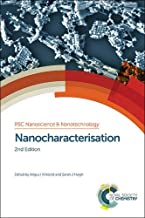Nanotechnology in the Defense Industry: Advances, Innovation, and Practical Applications
Original price was: ₹15,050.14.₹12,040.11Current price is: ₹12,040.11.
ISBN: 9781119460121
Author/Editor: Madhuri Sharon
Publisher: John Wiley
Year: 2019
1 in stock (can be backordered)
Description
This book will be about various aspects related to applications and use of knowledge of nanotechnology in promoting defense activities. The area in which scientists are focusing includes (i) nano-devices such as sensors, GPS & computers, chemical & biological weapons, nano-fabrics, bulletproof materials, nano-stealth coating, use of nanotechnology in various areas of aerospace. It is intended to cover available methodologies and understanding of technologies for these applications. Not only for destructive but also to improve medical and casualty, safety care for soldiers, and to produce lightweight, strong and multi-functional materials for use in body armour, both for protection and to provide enhanced connectivity will be covered.
Additional information
| Weight | 0.62 kg |
|---|
Product Properties
| Year of Publication | 2019 |
|---|---|
| Table of Contents | Preface xv Foreword xvii 1 Nanotechnology? Entry into the Defense Arena 1 Madhuri Sharon 1.1 Introduction 1 1.2 What is Nanotechnology 2 1.3 Nanotechnology Offers Innovative Opportunities for Defense 4 1.4 Nanotechnology for Soldiers 5 1.4.1 Smart Clothing Using Nanotechnology for Various Applications 5 1.4.2 Invisibility and Adaptive Camouflage 6 1.4.3 Armor Fabric 8 1.4.3.1 Artificial Muscles 9 1.4.3.2 Strong, Lightweight and Self-Repairing Material 9 1.4.3.3 Tungsten as Ultrastrong Material 9 1.4.3.4 Carbon Nanomaterials 9 1.4.3.5 Future Combat Suits 10 1.4.4 Faster Intensive Medical Help 11 1.4.4.1 Diagnostic Support Using Nanotechnology 11 1.4.4.2 Nano-Tourniquet 11 1.4.4.3 Antitoxin Guard 12 1.4.4.4 Lab-on-Chip 12 1.4.4.5 In-Situ Tissue Repair 12 1.4.4.6 Artificial Organs 13 1.4.5 Food and Safe Drinking Water 13 1.5 Increased Surveillance for Better Protection and Security 14 1.6 Smaller, More Effective and Cheaper Nanotechnology-Based Weapons 15 1.7 Nanotechnology in Aeronautics for Lighter and Faster Aircraft 17 1.7.1 Exfoliated Nanocomposites 18 1.7.2 Single-Wall Carbon Nanotubes (SWCNT), Double-Wall Carbon Nanotubes (DWCNT) and Multi-Wall Carbon Nanotubes (MWCNT) 18 1.7.3 Nanoplatelets and Nanofibers of Graphite/Graphene 18 1.7.4 Electrospun Nanofibers 19 1.8 Nanotechnology for Stealth Warships and Submarines for Ocean Exploration 20 1.8.1 Microwave Absorber for Stealth Technology 20 1.8.2 Invisible Stealth Ships, Planes and Vehicles 21 1.8.3 Radar Absorbing Material: Carbon Nanotubes (CNT) 22 1.8.4 Radar Absorbing Material: Ionic Liquids 23 1.9 Nanotechnology for Vehicles 23 1.9.1 Vehicles with Scratch Resistant Surfaces 24 1.10 Nanotechnology for Satellites 24 1.11 Nanomaterials for Portable Energy/Power 25 1.11.1 Portable Fuel Cells (FC) 25 1.11.2 Rechargeable Lithium (Li) Batteries 26 1.11.3 Supercapacitor 27 1.11.4 Solar Cells 27 1.12 Nanosensors 28 1.12.1 Chemical Nanosensors 29 1.12.2 Mechanical Nanosensors 29 1.12.3 Magnetic Nanosensors 30 1.12.4 Radiation Nanosensors 30 1.12.5 Portable Miniature X-Ray Nanosensors 30 1.12.6 Surface-Enhanced Raman Spectroscopy (SERS) Nanosensors 31 1.12.7 Smart Dust Sensors 31 1.13 Nanotechnology for Logistics 31 1.13.1 Smaller, Faster Nano-Cameras 32 1.14 Conclusions 33 References 34 2 Stealth, Counter Stealth and Nanotechnology 37 Madhuri Sharon 2.1 Introduction 37 2.2 Radar ?An Incentive for Developing Stealth 38 2.2.1 Principle of Radar 38 2.2.2 How Radar Functions 39 2.3 What is Stealth and Why Was It Developed? 40 2.4 Considerations and Efforts for Designing Stealth Aircraft 43 2.4.1 Camouflaging 43 2.4.2 Plasma Active Stealth 44 2.4.3 Inactivating Radar Signal or Making Planes Less Visible 45 2.4.3.1 Radar Absorbing Material (RAM) 46 2.4.3.2 What are Microwaves? 47 2.4.3.3 How are Microwaves Absorbed? 48 2.4.3.4 Microwave Transmitting Structures 51 2.4.3.5 Types of Microwave Absorbers 52 2.5 Radar Cross Section (RCS) 58 2.6 Shaping of Stealth or Improved Aerodynamics by Reducing RCS 59 2.7 Reducing the IR Signature 60 2.8 Muffling Aircraft Noise 61 2.9 What is Counter Stealth and Why is it Used? 61 2.9.1 LIDAR (Light Detection and Ranging) 62 2.9.2 Multi-Band 3D Radar 62 2.9.3 Quantum Radar 63 2.10 Nanotechnology for Improved Stealth Performance 63 2.10.1 Nanomaterials as RAM or Microwave Absorber 64 2.10.1.1 Nanoferrite Absorber 65 2.10.1.2 Nano-Carbon and Carbon Nanotube (CNT) Composites as Absorbers 68 2.10.2 Nanomaterials in Airframe Structure 72 2.10.2.1 Carbon Nanotubes (CNTs) Conjugated with Polymers 74 2.10.2.2 Nanoclay Reinforced Polymer Composites 78 2.10.2.3 Metal Nanoparticle Incorporated Composites 78 2.10.3 Nano-Metal Coatings for Aero-Engine Parts 79 2.10.4 Nanomaterials for Electro-Communication Component of Aircraft 80 2.10.4.1 Nanoparticles for Data Storage Media 80 2.10.4.2 Nanoparticles for Supercapacitors 82 2.10.4.3 MEMS and NEMS for Fuel Management 83 2.10.4.4 Other Applications of Nanotechnology in Supporting Advanced Stealth Systems 84 2.11 Conclusions 84 References 85 3 Nanocomputers in Aid of Defense 89 Angelica Sylvestris Lopez Rodriguez 3.1 Introduction 89 3.1.1 Classification of Nanocomputers 90 3.1.1.1 Electronic Nanocomputers 90 3.1.1.2 Mechanical Nanocomputers 91 3.1.1.3 Chemical and Biochemical Nanocomputers 91 3.1.1.4 Quantum Nanocomputers 92 3.1.1.5 DNA Nanocomputers 93 3.2 History of Nanocomputers 93 3.3 The Nanocomputers 97 3.3.1 Nanotechnology and Quantum Computers 98 3.3.2 Recent Advances in Nanocomputers 99 3.4 Applications of Nanocomputers in the Military 100 3.5 More Powerful Computers to Come 103 3.6 Summary 105 References 105 4 Nanotechnology-Aided Armor 109 Pio Sifullentes Gallardo 4.1 Historical Background of Armor 109 4.2 Nanomaterial-Aided Armor 111 4.2.1 Polymers 111 4.2.1.1 Polymerization Reaction 112 4.2.2 Carbon Nanoforms 118 4.2.2.1 Synthesis of Carbon Nanotubes (CNT) 119 4.2.2.2 Functionalization of CNT 121 4.2.3 Nanocomposites 122 4.2.3.1 Processes for Preparing Nanocomposites for Armor 125 4.2.4 Armor of Smart Nanomaterials 128 4.2.4.1 Memory Materials 129 4.3 Summary 131 References 131 5 Nanotechnology and Weapons 133 Chetna Sharon 5.1 Introduction 133 5.2 Considerations for Developing Nano High Energy Materials (HEMs) for Weapons 134 5.2.1 Propellants 135 5.2.2 Explosives 137 5.2.3 Pyrotechnics 139 5.3 Requirements for Nanoparticles Used in Nanoweapons 142 5.4 Synthesis of Nanomaterials for Weapons 143 5.5 Characterization of Nanomaterials Used in Weapons 146 5.6 Nanomaterials for Use in Nanoweapons and Ammunition 147 5.6.1 Super Penetrating Materials 147 5.6.2 Nanocrystalline Tungsten 148 5.6.3 Liquid Metal 148 5.6.4 High Energy Laser Weapons 148 5.7 Nanoweapons 149 5.7.1 Types of Nanoweapons 150 5.7.1.1 Molecularly Assembled Nanoweapons 151 5.7.1.2 Mini-Nukes and Mosquito-Like Robot Weapons 152 5.7.1.3 Invisible Nano-Needle Bullets 153 5.7.1.4 Non-Nuclear Bomb 153 5.7.1.5 Nanoweapons to Replace or Improvise Current Nuclear Weapons 154 5.7.1.6 New Nano Spies ?Nano-Sized Fighter Jets 155 5.7.1.7 CornerShot 155 5.7.1.8 Laser-Guided Weapons 156 5.7.1.9 Bullet Camera (TNO Concept) 157 5.7.1.10 Landmines and Improvised Explosive Devices 157 5.8 Defensive Measures to Combat Nanoweapons 158 5.9 Risks Posed by Nanoweapons 159 5.10 Need for Preventive Anti-Nanoweapon and Anti-Ecophagic Policies 160 5.11 Summary 160 References 161 6 Nanotechnology to Aid Biological and Chemical Warfare Defense 165 Madhuri Sharon 6.1 Introduction 165 6.2 What is Biological Warfare? 166 6.2.1 Types of Biological Warfare 170 6.2.1.1 Bacteria 170 6.2.1.2 Fungus 185 6.2.1.3 Virus 188 6.2.1.4 Insects 198 6.2.1.5 Biogenic Toxins 202 6.3 Chemical Warfare 209 6.3.1 Types of Chemical Weapons 210 6.3.1.1 Nerve Agents 210 6.3.1.2 Blister Agents 211 6.3.1.3 Choking Agents 212 6.3.1.4 Blood Agents 212 6.3.1.5 Riot Control Agents 213 6.4 How Nanotechnology Can Protect from Biological and Chemical Warfare 214 6.4.1 Nanosensors that Aid Biological and Chemical Warfare 214 6.4.1.1 Blue Crab Nanosensors 215 6.4.1.2 Nanowire Biosensors 215 6.4.1.3 Intracellular Biosensors 216 6.4.1.4 Biosensors 216 6.4.1.5 Nanosensor as Nano-Nose 217 6.4.2 Nanotechnology and Protective Clothing for Defense Personnel 217 6.4.2.1 Nanofabrics and On-Time Detection and Treatment 218 6.4.3 Nanorobotics and Other Futuristic Nano-Applications 224 6.5 Disadvantages of Nanotechnology 224 6.6 Summary 225 References 225 7 Smart Nanofabrics for Defense 235 Madhuri Sharon 7.1 Introduction 236 7.2 A Brief History of Smart Skin Material 238 7.3 Types of Smart Textiles 237 7.3.1 Passive Smart Textiles 238 7.3.2 Active Smart Textiles 238 7.3.3 Ultra Small Textiles 238 7.4 Fabrication of Smart Textiles 239 7.4.1 Metal Fibers 240 7.4.2 Conducting Inks 240 7.4.3 Inherently Conductive Polymers (ICP) 241 7.4.3.1 Polypyrrole (PPy) 242 7.4.3.2 Polyacetylene or Polyethylene or Polythene (PE) 242 7.4.3.3 Polyaniline (PANi) 242 7.4.3.4 Polythiophene and Its Derivatives 243 7.4.4 Electrically Conductive Polymers (ECP) 243 7.4.5 Optical Fibers 244 7.4.6 Shape Memory Material (SMM) 245 7.4.7 Chromic Material 246 7.4.7.1 Thermochromism 247 7.4.7.2 Photochromism 247 7.4.7.3 Electrochromism 247 7.4.7.4 Piezochromism 248 7.4.7.5 Solvation Chromism 249 7.4.8 Phase Change Materials (PCM) 249 7.5 Nanoparticle Coated Textiles 249 7.5.1 Antimicrobial Fabrics 250 7.5.2 Water Repellant (Hydrophobic Fabric), Stain Repellant and Spill Resistant Fabrics 250 7.5.3 Self-Cleaning Fabrics 252 7.5.4 UV Radiation Protection 253 7.5.5 Static Resistant or Anti-Static Fabric 254 7.6 Applications of Nanoparticle Coated Smart Textiles 254 7.6.1 Healthcare Fabrics 255 7.6.2 Self-Powered Smart Textiles 256 7.6.3 CNT-Based Smart Fabrics 259 7.6.3.1 CNT and Metallic Antennas for Smart Textiles 260 7.6.3.2 Cotton Coated with MWCNT for Energy Storage 261 7.6.3.3 CNT Braided Fabric for Monitoring Composites 261 7.6.3.4 CNT-Based Smart Electronic Textile 262 7.7 Sensors for Smart Textiles 263 7.7.1 Temperature Sensor 264 7.7.2 Humidity Sensitive Textiles 265 7.7.3 Capacitive Pressure Sensors 266 7.7.4 Resistive Pressure Sensors 266 7.7.5 Optical Textile Sensors 267 7.8 Actuators for Smart Textile 267 7.9 Summary 269 References 269 8 Nanomaterial for Adaptive Camouflage and Structure 275 Angelica Sylvestris Lopez Rodriguez 8.1 Introduction 275 8.2 Camouflage 277 8.3 Camouflage for the Military 279 8.4 Types of Camouflage 280 8.4.1 Woodland Camouflage 280 8.4.2 Desert Camouflage 280 8.4.3 Desert Camouflage of Three Colors 280 8.4.4 Digital Army Combat Uniform (ACU) Camouflage 281 8.4.5 Tiger Stripe Camouflage 281 8.4.6 City or Urban Camouflage 282 8.5 Active or Adaptive Camouflage 282 8.6 Nanomaterials for Advanced Camouflaging 288 8.6.1 Some Possibilities in the Near Future 285 8.7 Summary 286 References 286 9 Applications of Nanotechnology in Aerospace 289 Madhuri Sharon 9.1 Introduction 289 9.2 Use of Nanomaterials in Different Areas of Aviation 291 9.2.1 Airframe Structure 291 9.2.1.1 Commonly Used Aluminum Alloys in Heavier Parts of the Aircraft 292 9.2.1.2 Commonly Used Aluminum Alloys in Other Parts of the Aircraft 294 9.2.1.3 Aluminum Oxide Nanoparticles 294 9.2.1.4 Nanomaterials for Airframe Structures 295 9.2.2 Nanocoating 296 9.2.3 Aero Engine Parts 300 9.2.4 Aircraft Electrocommunication System 300 9.2.5 Radar Technology for Detecting Landmines 304 9.3 Possible Uses of Graphene in Aerospace 304 9.4 Stealth Technology 306 9.5 Summary 306 References 307 Index 309 |
| Author | Madhuri Sharon |
| ISBN/ISSN | 9781119460121 |
| Binding | Hardback |
| Edition | 1 |
| Publisher | John Wiley |
You must be logged in to post a review.






Reviews
There are no reviews yet.